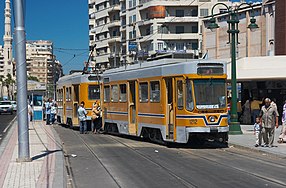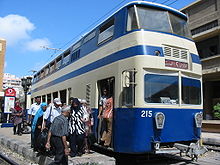Alexandria Tram
| Alexandria Tram | |
|---|---|
| Quite tram in Al Madina | |
| Basic information | |
| Country | Egypt |
| city | Alexandria |
| opening | January 8, 1863 |
| electrification | 1902 |
| operator | APTA |
| Infrastructure | |
| Route length | 32 km |
| Gauge | 1435 mm ( standard gauge ) |
| Stops | > 140 |
| business | |
| Lines | 20th |
| vehicles | 283 |
| Network plan (as of 1996) | |
The Alexandria tram in the Egyptian city of Alexandria (Arabic: al-Iskandariyya ) has been in operation since 1863, making it one of the oldest in the world and the oldest in Africa . Before the current tram renaissance, they and the Cairo tram, founded in 1886, were the only ones on this continent for decades.
Its special features include seven double-decker control cars ; Double-decker trams , which used to be common in many countries of the British Empire , now only run in Hong Kong and Blackpool .
history
The tram was founded in Alexandria on the initiative and with the support of British merchants. Only after the end of the reign of Governor Muhammad Said Said Pasha in 1860 was it possible to obtain permission to build and operate a tram. In the same year, on August 16, 1860, the British merchant Sir Edward John was granted the concession.
On January 8, 1863, the first line was opened, apart from its splits, today's Ramlehbahn. Initially, the wagons were pulled by horses . Almost three decades later, from August 1898, steam locomotives were used. Just four years later, the first electric vehicles hit the rails in 1902. With electrification, the number of passengers increased enormously, also because the lines were extended and new ones were added.
Network and operation
Alexandria lies on a narrow strip of land between the Mediterranean Sea and the shallow, salty and lagoon-like Lake Mariut (بحيرة مريوط / Buḥayrat Mariyyūṭ ). The city's public transport is operated by APTA (Alexandria Governorate's for Public Passenger Transport Agency).
The tram network has standard gauge and today a total length of 32 kilometers. It consists of two sub-networks, which are located at the Ramleh station (محطة الرمل / maḥaṭṭat ar-Raml ), which is located on the eastern edge of the city center, not far from the eastern port (الميناء الشرقي / al-Mīnāʾ aš-Šarqī ). In English they are often referred to as the “Ramleh line” and “City line”, although according to the timetable they each consist of several lines.
The four lines of the Ramleh tram (ترام الرمل / Turām ar-Raml ) have the numbers 1, 2, 25 and 36. They are the more modern and are used by the blue cars. Its network of 38 stops consists of a long and straight connection, though partially split into two parallel routes, between the ar-Ramleh station and the an-Nasr station (محطة النصر / maḥaṭṭat an-Naṣr ), next to the an-Nasr- or Viktoriabahnhof (محطة فيكتوريا / maḥaṭṭat Fīktūriyyā ) lies. Most of the Ramleh lines have had their own tracks since the 1950s. The blue trains have pantographs , drive with closed doors and fast.
The multi-branch network of the al-Medina tram (ترام المدينة / Turām al-Madīna ) with its 16 city lines is used by the yellow (or, on two lines, actually red) carriages and opens up the Madina (old town) and its surroundings with over 100 stops. The tracks lie on the lanes, so that the trams are often stuck in traffic jams. The cars usually have pantographs , drive mostly with open doors and often so slowly that courageous passengers jump up or down during the journey. Most of the trains are old, many from the 1960s.
The Alexandrian tram is very popular with the population because the fares are low. Tourists also like to use them because they drive above ground and are very slow so that they can see everything in peace while driving. The front or, in the case of three-car trains, the middle car is reserved for women .
Vehicle fleet
Alexandria has a total of 283 trams. Most of the vehicles (124 pieces) come from the manufacturer Kinki Sharyo from Japan. These blue and white painted cars also include 6 double-decker control cars. 99 Duewag articulated cars were procured from the Copenhagen tram, which was closed in 1972 , and almost all of them are still in service.
Most trains have yellow trolley booms , most blue trains pantograph (pantograph) , which are converted with a substructure because of the double-decker cars and the higher-hanging power had when she should go to Alexandria in operation. There are also wagons that have both types of customers.
Despite the generally low standard of living in the country, some enthusiasts have exemplary restored an Oerlikon (MFO) railcar from 1931 . This car with the number 601 is kept ready for tourist trips.
In September 2015, numerous used Tatra KT4Dm and T6A2m from Berlin and Potsdam were bought and are intended to significantly rejuvenate the Alexandria tram fleet in the future. However, the vehicles are still not in use (as of the end of March 2017).
In 2017, 15 new K1E6 vehicles were ordered from the Ukrainian manufacturer Tatra-Yug. The new trams are helping to rejuvenate the vehicle fleet and could be observed across the entire network in 2020.
Web links
- http://www.tramway.com/fleet-list-egypt-2010.pdf (link not available)
- Complete "Yellow Trains" wagon list (Russian)
- Complete list of wagons "Blue Trains" (Russian)
- Video with impressions of the street scene in Alexandria with its trams
- Photos of all important rail types in Alexandria on Drehscheibe.de
Individual evidence
- ↑ www.virtualtourist.com
- ↑ a b Alexandria ( Memento from September 14, 2011 in the Internet Archive )
- ^ Roland Dussart Desart and Mike Russell: Egypt: Four tramways are now five !, Part 2: Alexandria. Light Rail Transit Association, United Kingdom, March 2005, pp. 96-99.
- ↑ http://subways.net/egypt/alexandria.htm
- ↑ Railway pictures
- ↑ Railway pictures
- ↑ Turntable Forum








